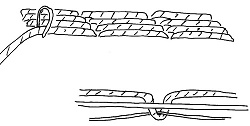
Underside couching
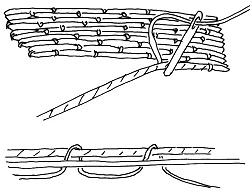
Surface couching
(diagramms by Th. Schoenholzer)
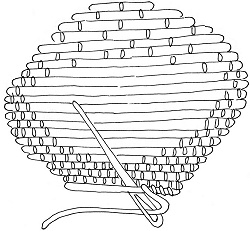
Shaded gold or "or nué" technique
gold thread
on surface only:
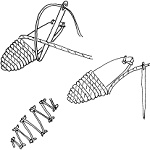
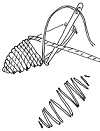
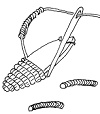
gold thread on both sides:
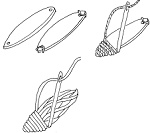
Relief Embroidery
| ANNE WANNER'S Textiles in History / cieta conference in Brussels, Belgium - 2009 |
| Medieval
Embroidery Stitches and the
Vocabulary Project. Paper at the Cieta Conference in Brussels 2009, by Anne Wanner |
| 2 years ago in Como I
presented the structure of a Vocabulary of Embroidery
stitches. In this paper I am going to point to a few basic stitches which were used in medieval embroidery. Also I want to tals about the development and modification of these stitches in later periods. Besides I am going to show that one and the same stitch may look quite different according to the material used, and to the place and region of realization. In-depth analysis and discussion of the stitches and their variations both from the front and the reverse side, might allow new insights of the historic embroideries in terms of dating and provenance. |
| At first I am talking
about the technique of couching. Couching as a style permits the decorative use of threads and cords that are - either too stiff or heavy to be effectively worked through a fabric - or too precious for any part to be wasted unseen on the “wrong side” Irene Emery in her Primary Structure of Fabrics differentiates between: the action of “laying” and the action of “couching”. She defines the long surface threads as “laid” and the shorter tying down stitches as “couching”. For these 2 functions different qualities of thread or of colours may be used, furthermore it is possible to use one and the same material. Part I The materials used are - gold for the laid threads and silk or linen for the tying down threads. The gold thread was expensive and the most economical use of it was to take the thread backwards and forwards across the surface of the ground, holding it in place by fine stitches of different material. |
- In underside couching,
also known as “opus anglicanum”: the thread
is laid on the upper face of the ground it is held in
place by a loop of linen or silk thread brought
from the back of the work. This method was used extensively throughout the Middle Ages. It produced an embroidery technique which had a good degree of flexibility. The use of the technique declined in the 15th c. and it was superseded by the simpler surface couching. - Surface couching: In time these holding stitches came to form a subtle decorative element on the couched threads themselves. They were placed with great precision to form zigzags, diaper grounds and more decorative motifs. - The technique of shaded gold or Or nué: The couching stitches in silk material were used to create solid blocks of colour over the gold thread. This technique became a new form of needle painting by embroiderers in Italy and Flanders in particular. A painterly quality with the richness of metallic gold thread was achieved. It requires great skill and precision on the part of the embroiderer. The peak of perfection was reached in the 15th c. Very famous surviving examples are a series of decorative panels designed by Ant. del Pollaiuolo in the 15th c. - Relief embroidery is sometimes found in the same object, straight beside the or nué technique: As in underside couching the gold thread may only show on the surface, in this case it is hold in place by a loop of linen thread brought from the reverse side of the work. On the front, thick cotton thread is used as padding underneath the gold couching giving a 3rd dimension to the couched surface. Relief embroidery is often combined with metal threads and spangles. |
 Underside couching  Surface couching (diagramms by Th. Schoenholzer) |
 Shaded gold or "or nué" technique |
gold thread
on surface only: |
| Part 2 Wool is used as a material of embroidering Most of the times couching with wool is realized with one and the same thread, which means that the same element is used for both actions. The embroidering thread being first “laid” across the area to be covered, and then used to couch the “laid” segment. These two actions are then repeated row by row. One single thread is required and the work is also called self couching. Other names are “Bokhara couching”, Roumanian couching, convent stitch. The first example here is a variation of self couching, this very well known example is a detail of Bayeux tapestry around 1066. A specific area is covered with laid threads at first. These threads are then fastened with widely spaced self couching stitches. |
With the
following examples I am presenting the techniques of
self couching in other regions: In the embroidery of lower Saxony, north of Germany around 1300 the laid stitches are very closely worked together, most of the times in vertical directionand they completely cover the ground fabric. The tye down stitches are sometimes very small and they fasten the laid stitches horizontally. Sometimes these stitches are quite long and in a slanting position. They may drift to the left or to the right. By working one row with drifting stitches to the right and the next one to the left, an additional ornamentation is possible. The area covered with stitches may look as if worked with chainstitch or with stemstich. Wool embroideries in Switzerland of the 17th c. At first sight one believes that here the very same self couching technique was used. Also here the laid stitches are closely worked together. As a difference: very often the black woolen ground fabric shows as well, the ground fabric becomes an important part of the design. Another difference: the laid threads follow the outlines of the single forms. And: the overcast or tying down stitches are most of the times quite short and at right angles to the laid thread. |
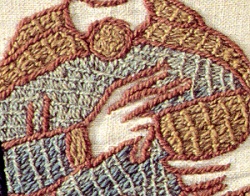 Bayeux Tapestry, 1066 |
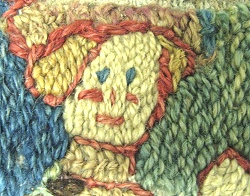 Northern Germany, 14th c. |
|
| In Part 3 Linen is used as material of embroidering I am very grateful to Mrs Youlie Spantidaki who sent to me her interesting analyses of the embroidery of an altar veil. The discussion with her opened new insights on variations of embroidery stitches. This example is an embroidery of the Benaki Museum in Athens. Some other, similar white altar veils are preserved in northern Germany. They oritinated in 13th and 14th century. The couching with Linen is a self couching technique slightly different to the self couching with wool we observed just before. - here we find laid threads which are very short, the direction of these laid threads may be straight. But as the embroidery is quite free, a slightly slanted position is possible. - the laid threads appear in several rows one below the other. These rows my be encroached in the one above. - the tyeing down stitch very often are quite long and slanting. Characteristic for this variant is the slight relief in the filled areas. With this relief a very subtle lighting effect is reached. |
Linen embroideries are
very rich in a variety of interesting stitches: The open chain stitch here used for outlines may be related to the group of the Looped Stitches. Irene Emery (p.241)defines these stitches as: flat stitches pulled out of the straight nd forced into a loop. Or with other words: Looped stitches are pulled to one side by looping the thread under the needle. Basic form and prototype of the looped stitches is the buttonhole stitch. If the loop of the buttonhole is completed, a chain stitch is generated. I am pointing to some variations of the chain stitch a) the loop may be closed at approximately the same point where it emerged. b) there is the detached chain stitch for flowers and so on c) in broad chain stitch or open chain stitch there is a distance between the point where the stitch emerges to the point where it enters the fabric again. There are 2 different ways of working the reverse side d) another possibility is to twist the loop. Below there are details of the fragment of Athens and details of an altar veil of the convent of Lüne in northern Germany of around 1300: Here the open chain stitch is used for outlines. |
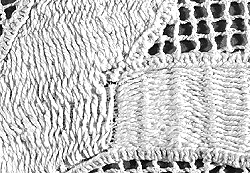 detail of embroidery of the Benaki Museum in Athens. |
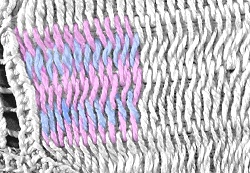 detail of embroidery of the Benaki Museum in Athens. |
|
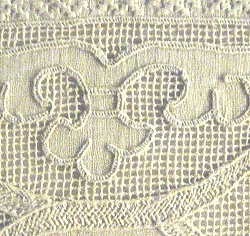 detail of altar veil of convent of Lüne in northern Germany of around 1300 |
   interweaving of herringone stitches |
|
| The altar veils of Luene
are showing some other embroidery stitches. As for
example variants of herringbone stitch. Irene Emery defines these stitches as two part constructions: - The slanting stitch may cross over one square. - another possibility is that one part crosses over one square, the other over 2 squares. - In herringbone stitch each stitch segment crosses another and is crossed by a third. This fact opens many ways of plaiting or interweaving. The Herringbone stitch penetrates the ground fabric by a horizontal stitch - vertical stitches are also possible - sometimes this stitch is just hooked in other stitches or in edges - And according to the length of this stitch there may be different appearances. |
In an altar veil of
northern Germany around 1300 several rows of
herringbone stitch are set one above the other and
plaited one with the others. As the diagram and
the samplers show there are 4 rows worked one into
the other. And these plaited stitches only show on the
surface of the fabric. They are penetrating the ground
fabric only by few short stitches. Moreover there is the possibility of plaiting an additional thread into a framework of herringbone stitches. This Maltese Cross Filling Stitch is found in Swiss Linen Embroidery of 16th and 17th c. Here as well several ways of the working of the stitches are possible and most of the times it is the reverse side that makes clear whether the plaiting is worked in 2 foundation rows set one above the other or set one below the other. |
 |
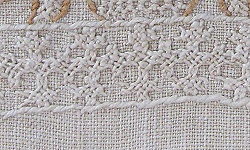 |
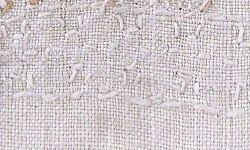 |
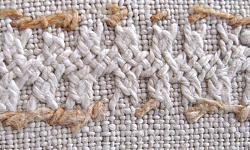 details of linen embroidery front
|
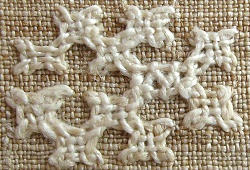 Maltese Cross Filling Stitch, all examples found in Swiss Linen Embroideries of 16th and 17th c., Textilmuseum St.Gallen, Switzerland. |
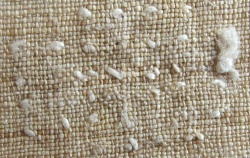 details of linen embroidery, reverse |
| Summary: This paper tries to show the importance of regional embroidery. Therefore examples of historic embroidery are included in the Vocabulary project. Samplers of stitches are shown both from the front and the reverse side. First and foremost the pictures are acting as reference for the terms in several languages. The Vocabulary itself emphasises differences between the variants. However it does not give instructions for the execution of embroidery stitches. In the course of time very often more than one term for a single stitch developed. The numerous and mostly very different terms also deserve to be collected. This Vocabulary in question can be consulted in its entirety in the Internet. The development potential of the glossary lies in the digital database, which may be continually updated with any new information on the names or variants of the embroidery stitches. As it seem more easy to quote a printed publications, a first booklet on cross stitch is now published. Similar publications on looped stitches, on couched work and so on may hopefully follow. |
| home | Last revised October 20, 2009 |